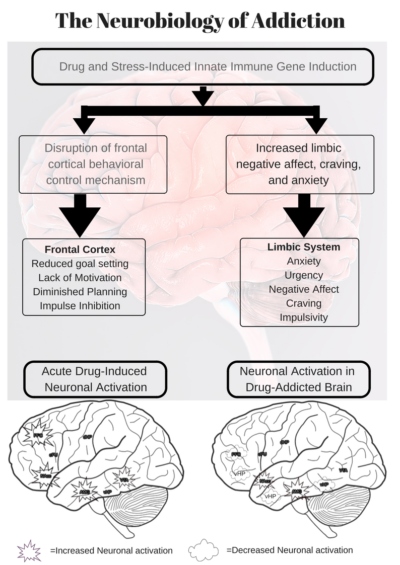…it is just another trait that has a neurological and biochemical foundation.
The advocates of the disease theory fail to realize that human brain is a versatile organ. Adaptability is its natural weapon. This molding of the brain is an outcome of the fact that it is constantly developing and learning — not diseased. All significant and repeated experiences change the brain and so does addiction. Being addicted is, therefore, not abnormal. However, addiction, being a maladaptive form of learning, brings changes that are fatal.
Currently, addiction affects 23.2 million Americans, of whom only 10% are receiving the treatment they need.
So what exactly does a habit or substance do to a person’s brain that propels him to the point of losing his freedom or even his life, just to have it? In other words, what goes on inside the mind of an addict?
For an addict, the drug experience (not just the substance, but the entire scene as well) becomes indelibly etched into the physiological brain circuitry.
Addictionologists have theorized that abused substances like amphetamines, alcohol, nicotine, etc, work by interfering with the brain’s reward system.
A pinball machine, much like the human brain, is made up with an intricate weaving of electronic and mechanical parts. Just like when the start button is pressed, a pinball from the trough is placed into the launch lane in front of the plunger, the abused substance or a behaviour stimulates the release of dopamine neurotransmitter in the nucleus accumbens, which is the key structure in the experience of pleasure.
Because the synapse is so complex, there is a variety of sites at which drugs may affect synaptic transmission. One way to affect synaptic transmission is to increase the amount of neurotransmitter released into the synaptic space. Drugs like alcohol, heroin, and nicotine indirectly excite the dopamine-containing neurons in the ventral tegmental area (VTA) so that they produce more action potentials. As the number of action potentials increases, so does the amount of dopamine released into the synapse.
Prolonged substance/behavioural abuse eventually desensitises most receptors (a phenomenon known as tolerance), raising the level of pleasure threshold and, hence, causing a further more intake of the substance. The neurons in the nucleus accumbens and the prefrontal cortex (the area responsible for planning and executing tasks) start communicating in a way that drives motivation to chase the drug/habit.
While positive reinforcement (pleasure, getting high) entices a person to use a drug repeatedly, continued use is often a function of negative reinforcement. Tobacco smokers and opiate users experience this the most: Their motivation to use the drug is not to experience pleasure, but to relieve uncomfortable withdrawal symptoms.
The risk of addiction, therefore, is influenced by a combination of genetic, environmental and developmental factors.
What happens in Obsessive Compulsive Disorder: The Molecular Picture
Obsessive Compulsive Disorder is most commonly characterised by “obsessions” or recurring uncontrollable, intrusive thoughts and “compulsions” or behaviors that a person feels the urge to repeat over and over; though sometimes it can manifest in different forms as well. Read More..










